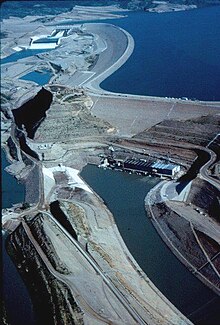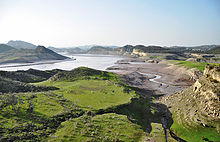Mangla Dam
| Mangla Dam | |
|---|---|

Mangla Dam Aerial View
| |
|
Location of Mangla Dam in Pakistan
| |
| Country | Pakistan |
| Location | Mangla, Azad Kashmir |
| Coordinates | 33.142083°N 73.645015°E |
| Status | Operational |
| Construction began | 1961 |
| Opening date | 1967 |
| Dam and spillways | |
| Type of dam | Embankment dam |
| Impounds | Jhelum River |
| Height | 147 m (482 ft) |
| Length | 3,140 m (10,302 ft) |
| Reservoir | |
| Creates | Mangla Lake |
| Total capacity | 9.12 km3(7,390,000 acre·ft) |
| Surface area | 97 sq mi (251 km2) |
| Power station | |
| Turbines | 10 x 100 MW |
| Installed capacity | 1,150 MW (15% overload) 1,500 MW [1](max. planned) |
The Mangla Dam (Urdu: منگلا بند) is a multipurpose dam located on theJhelum River in the Mirpur District of Azad Kashmir, Pakistan. It is the 7thlargest dam in the world. The project was designed and supervised by Binnie & Partners of London (the team led by partner Geoffrey Binnie),[2] and it was built by Mangla Dam Contractors, a consortium of 8 U.S. construction firms, sponsored by Guy F. Atkinson Company of South San Francisco.[3]
Contents
[hide]Background[edit]
As part of the Indus Waters Treaty signed in 1960, India gained rights to the waters of the Ravi, Sutlej and Beas rivers, while Pakistan, in addition to waters of the above three rivers within Pakistan and some monetary compensation, received the rights to develop the Jhelum, Chenab and Indus river basins. Until 1967, the entire irrigation system of Pakistan was fully dependent on unregulated flows of the Indus and its major tributaries. The agricultural yield was very low for a number of reasons, the most important being a lack of water during critical growing periods. This problem stemmed from the seasonal variations in the river flow due to monsoons and the absence of storage reservoirs to conserve the vast amounts of surplus water during those periods of high river discharge. [4][5]
The Mangla Dam was the first of the two dams constructed to reduce this shortcoming and strengthen the irrigation system of the country as part of theIndus Basin Project, the other being Tarbela Dam on River Indus.
Construction[edit]
Cost[edit]
Mangla Dam was constructed at a cost of Rs. 15.587 billion (US$1.473 billion) with the funding being provided by the World Bank and the Asian Development Bank.[6]
Reservoir[edit]
The dam was constructed between 1961 and 1967 across the Jhelum River, about 67 miles (108 km) south-east of the Pakistani capital, Islamabad inMirpur District of Azad Kashmir, . The Mangla Dam components include a reservoir, main embankment, intake embankment, main spillway, emergency spillway, intake structures, 5 tunnels and a power station. Besides the main dam, a dyke called Sukian – 17,000 feet in length and a small dam called Jari Dam to block the Jari Nala – about 11 miles beyond the new Mirpur town had to be constructed.
There was a total of 120 x 106 cubic yards (cu yds) of excavation for the reservoir whereas the total fill amounted to 142 x 106 cu yds and concrete to 1.96 x 106 cu yds respectively. The main embankment is earthfill with clay as the core material. Gravel and A-type sandstone are applied on the shoulders. The maximum height of embankment above the core trench is 454 feet and the length is 8,400 feet. The intake embankment is earthfill type with B-type sandstone as the core material. Gravel is applied on the shoulders. The maximum height of intake embankment above the core trench is 262 feet and the length is 1,900 feet.
Sukian Dam is earthfill with B-type sandstone as the core material. A-type sandstone is applied on the shoulders. The maximum height of the intake embankment above the core trench is 144 feet and the length is 16,900 feet.
Jari Dam is also an earthfill type with silt as the core material. Gravel is applied on the shoulders of the dam. The maximum height of Jari dam above the core trench is 274 feet and the length is 6,800 feet. The main spillway is a submerged orifice type with 9 radial gates, 36 x 40 feet each; it has a maximum capacity of 1.1 million cusecs. The emergency spillway is weir type with an erodible bund and a maximum capacity of 0.23 million cusecs. The 5 tunnels are steel and concrete lined and 1,560 feet long in bedrock. The internal diameter ranges between 26 and 31 feet.[7]
Power house[edit]
The power house, which consists of turbines, generators and transformers, has been constructed at the toe of an intake embankment at the ground surface elevation of 865 feet SPD. The water to the power house is supplied through five steel-lined tunnels of 30/26 feet diameter. Each tunnel is designed to feed two generating units. The power house tailrace discharges into New Bong Canal, which has a length of 25,000 feet with discharge capacity of about 49,000 cusecs, and terminates at an automatic gate control headworks at about 12 km downstream located near old Bong Escape Headworks.[8][9]
There are ten vertical Francis type turbines in the power house. Each of these turbines has an output of 13,800 bhp with a rated head of 295 feet of water. The first four turbines were manufactured by Mitsubishi Electric, Japan and were installed in 1969, turbines 5 and 6 are manufactured by ČKD Blansko, Czech Republic and were installed in 1974, turbines 7-8 were manufactured by ACEC, Belgium and were installed in 1981, while the remaining two turbines are a make ofŠkoda, Czech Republic and were commissioned in 1994.[1][8]
These turbines are connected to umbrella-type generators which have a generation capacity of 100 MW. Hitachi, Japan had provided generators for turbines 1–4 and 7-8 while Škoda generators are connected to turbines 5-6 and 9-10.
These generators are in turn connected to three-phase transformers. The transformers connected to turbine 1, 4 and 7 were manufactured by the Italy-based Savigliano. The transformers for turbine 5 and 6 are a make of Italtrafo, another Italian company, while the remaining five transformers were provided by Škoda.[8]
Displacement & Resettlement[edit]
The Government of Pakistan had agreed to pay royalties to the Government of AJK (Azad Jammu and Kashmir) for the use of the water and electricity generated by the dam. Over 280 villages and the towns of Mirpur and Dadyal were submerged and over 110,000 people were displaced from the area as a result of the dam being built.[10] Some of those affected by the dam were given work permits for Britain by the Government of Pakistan, and as a result, in many cities in the UK the majority of the 'Pakistani' community actually originated from the Dadyal-Mirpur area of Azad Kashmir.[11] There are 747,000 Mirpuris in the United Kingdom,[12] the British Mirpuri community forms about 70% of the British Pakistani community. The percentage is even higher in northern cities and towns. For example, in Bradford, an industrial town in north-west England, it is estimated that roughly three quarters of the population are from Mirpur.
Operation[edit]
The project was designed primarily to increase the amount of water that could be used for irrigation from the flow of the Jhelum and its tributaries. Its secondary function was to generate electrical power from the irrigation releases at the artificial head of the reservoir. The project, though not initially designed as one, also works as a flood control structure by retaining water during the flood-prone season of Monsoon.[11]
On December 5, 1971, the dam was damaged due to a bombing raid conducted by the Indian Air Force during the Indo-Pakistani War of 1971. This was against the international convention that large water reservoirs would not be targeted in war. As a consequence, the hydro project was temporarily out of service.[13][14]
From the data available in 2009, the project had generated 183.551 billion units of low cost Hydel energy since its commissioning. The annual generation during 2008-2009 was 4797.425 Million KWh while the station shared a peak load of 1150 MW which was 8.18% of the total WAPDA system peak.[8]
On 1 September 2013, the water level in Mangla Dam reached to a record height of 1237.15 feet against the maximum conservation level of 1242 feet. Radio Pakistan reported that "the water level in Mangla Dam has attained maximum height of 1237.15 feet in the history and it is still increasing." [15]
Mangla Dam Raising Project[edit]
Mangla reservoir had an initial reservoir capacity of 5.88 Million Acre-feet (MAF), which reduced to 4.674 MAF in 2005 due to the sedimentation & was likely to reduce further. To counteract this phenomenon, the Mangla Dam Raising Project was started in 2004 and the main dam, spillway and its allied works were completed in 2009 at a cost of Rs. 101.384 billion. This project effectively raised the dam height by 30 feet to 482 feet (147 m), thereby raising the maximum water conservation level from 1202 feet to 1242 feet.[1][16] This increased the dam's storage capacity by an additional 2.88 MAF from 4.51 MAF to 7.39 MAF.[17] Besides, it is expected that after raising the height of the Mangla Dam by 30 feet, the power house will generate 12 percent additional energy per year which will increase its installed capacity from 1,000 MW to 1,120 MW.[18]
The Mangla Dam Raising Project, however, has affected more than 40,000 people living in vicinity of the dam. The total cost of compensation and resettlement was Rs. 70 billion. The resettlement project includes the construction of New Mirpur City, four satellite towns (Islamgarh, Chakswari, Dadyal, Siakh) with all civic amenities, the Mirpur Bypass and two bridges acrossRiver Jehlum and Bong Canal respectively.[7][19]
Mangla Power House Expansion Project[edit]
In November 2012, United States announced a grant of $150 million for the expansion of the Mangla Dam power house. Under the project, $400 million would be spent on the Mangla Dam power house which is estimated to provide additional production for the next 40 years. The project, when complete, will increase the power generation capacity of the Mangla Dam to 1,310 MW from the existing 1000 MW capacity.[20]






Did you know that that you can make dollars by locking special pages of your blog or site?
ReplyDeleteSimply join Mgcash and implement their Content Locking widget.
Are you making money from your exclusive file uploads?
ReplyDeleteDid you know Mgcash will pay you an average of $0.50 per file download?